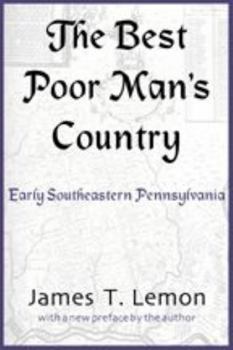The Best Poor Man's Country: Early Southeastern Pennsylvania
Select Format
Select Condition 
Book Overview
Winner of the Albert J. Beveridge Award of the American Historical Association In many respects early Pennsylvania was the prototype of North American development. Its conservative defense of liberal individualism, its population of mixed national and religious origins, its dispersed farms, county seats, and farm-service villages, and its mixed crop and livestock agriculture served as models for much of the rural Middle West. To many western...
Format:Paperback
Language:English
ISBN:0801868912
ISBN13:9780801868917
Release Date:August 2002
Publisher:Johns Hopkins University Press
Length:332 Pages
Weight:0.50 lbs.
Dimensions:0.7" x 6.0" x 9.0"
Customer Reviews
1 rating
thorough, academic, still worthwhile
Published by Thriftbooks.com User , 16 years ago
For those willing to put in some effort, Lemon's book is a very good study that is not at all poorly written and reaches out beyond an audience of academic scholars even while staying within a somewhat restrictive structure. His thesis is exactly what the title indicates: that the settlement and economic development which occurred in colonial southeastern Pennsylvania was the result of the richness of the land, the abundance of social opportunity, and resulting momentum generated by this fortunate "geography," a term that encompasses, as the subject of geography does, a whole host of physical, cultural, and social characteristics that interact with other over time to create a unique landscape in a particular place - in this case, colonial southeastern Pennsylvania. This book is a geographic study, and the language of academic geography is not readily accessible to most Americans, who have no background in true geographic thought, even those with an adequate understanding of and interest in popular geography. For example, Lemon's lengthy academic exercise, wherein he assesses how well settlement patterns and land uses approximate von Thunen's agricultural land use model is a bit of a slog - good academic prose, but a bit arcane of a subject even for today's academic geographers or college students. Certainly, reading The Best Poor Man's Country is not like reading a book by John McPhee, nor was it meant to be. Lemon does not set out to weave a good yarn, where curiosity-driven diversions are neatly tied together as a piece of creative non-fiction. Instead, he follows a very careful and thorough, albeit somewhat dry, scientific tradition; he wrestles with a lot of data for the purpose of making a convincing and interesting argument, and then makes it again from other angles in subsequent chapters, and perhaps develops it a little deeper, too. He demonstrates that geographic ideas and theories and a lot of historical documents can be used to reconstruct and explain how and why early southeastern Pennsylvania developed in the way that it did. This secondary purpose, common in academic studies, can obfuscate the plainer story summed up in the words of the title.






